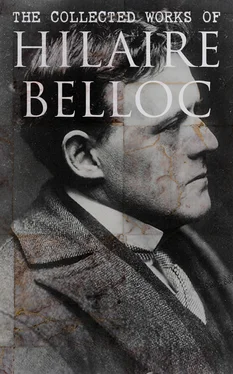It was mid-morning before the ebb was at its lowest, 9and they could begin to march “twelve abreast, and with the water no more than knee-high,” across the dwindled stream now at its lowermost of slack water, and running near the further bank with a breadth not a fifth of what it had been at the flood. But before proceeding further and describing the assault shore, I would lay before my readers the process by which I have established the exact locality of this famous ford. It has been a matter of considerable historical debate. It is and will always remain a matter of high historical interest, and this must be my excuse for digressing upon the evidence which, I think it will be admitted, finally establishes the exact trajectory of Blanchetaque.
The site of Blanchetaque is one which nature and art have combined to render obscure: nature, because a ford when its purpose disappears and it is no longer kept up, that is, an artificial ford, tends to disappear more rapidly than any other monument; art, because the old estuary of the Somme has of recent years been further and further reclaimed. It was, when I first began studying this district, already banked across below Boismont, and, if I am not mistaken, the great railway bridge right across the very mouth of the river has, in the last few months, been made the boundary of the reclaimed land.
Now, Blanchetaque was an artificial ford. We know this because there is no marl formation near by, and could be none forming a narrow rib across the deep alluvial mud of the estuary; the marl, then, can only have been brought from some little distance. It is not only an artificial hardening which we have to deal with, but one in the midst of a tidal estuary where a violent current swept the work for centuries. Finally, the cause for keeping the ford in some sort of repair early disappeared in modern times before the process of reclaiming the land of the estuary began. Numerous modern bridges, coupled with the great development of modern roads, permitted the crossing of the Somme at and below Abbeville: notably the Bridge of Cambron. The railway, the growth of the tonnage of steamers, and other causes, led to the decline of the little riverside town of Port—formerly the secure head of marine navigation upon the river and largely the cause that Blanchetaque was kept in repair.
Again, the reclamation of the land has been carried out with a French thoroughness only too successful in destroying the contours of the old river bed. In the sketch map on p. 60 I have indicated to the best of my ability the channel of the river at low tide as it appears to have been before reclamation began, but even this can barely be traced upon the levelled, heightened, and now fruitful pastures.
It is all this which has made the exact emplacement of Blanchetaque so difficult to ascertain, and has led to the controversies upon its site.
Now, if we will proceed to gather all forms of evidence, we shall find that they converge upon one particular line of trajectory which in the end we can regard as completely established.
We have in the first place (and most valuable of all, of course) tradition. Local traditions luckily carefully gathered as late as 1840, 10but the indications of the peasants pointing out the traditional site of the then ruined way were, unfortunately, not marked on a map. What was done was to give an indication unfortunately not too precise, and to leave it on record that the northern end of the ford was “from 1200 to 1500 metres below Port.” This gives us a margin of possible error, not of 300 yards as might be supposed, but of more than double that distance, for Port itself is 500 yards in length from east to west. We can be certain, however, that so far as tradition goes we need not look more than a mile below Port for the ford, nor less than say half a mile from its last houses.
Fortunately, we have other convergent indications which can guide us with greater precision.
We must remember that, apart from the bringing of merchandise over to the neighbourhood of Port, the ford, which may, and most probably did, exist before Port became of any importance, led all the central traffic of the Vimieux country (which is the district on the left bank of the Somme) towards the Straits of Dover and their principal port at Boulogne.
Now, the way from the right bank of the Somme to Boulogne is interrupted by several streams, much the most marshy and broad of which is the Authie. The Romans bridged the Authie at Ad Pontes in the course of their great Trunk Road to Britain, and any way which led from the lowest ford over the Somme to Boulogne would have to join that great Trunk Road before or at the bridge if it were to take advantage, as commerce would have to do, of that sole passage of the very difficult and marshy Authie valley which can nowhere be crossed save upon a causeway. I have in a former page remarked upon the importance of Ad Pontes (the modern Ponches), and pointed out that it gives the whole county its name of Ponthieu. We must expect, therefore, any direct commercial way northward from the ford to make directly for Ponches. To strike the great Trunk Road higher up would be to go out of one’s way; to strike it lower down would be to strike the Authie Valley at an impassable point.
When an ancient way has disappeared, certain indications of its track, especially as that track may be presumed to be direct, survive, and among these are wayside tombs, parish boundaries, and mills or other places which, for the conveyance of heavy merchandise, are placed near such a road if possible. All these three kinds of indications are available in this particular case. The medieval mill which was so important a monopoly of the medieval community was not built in the most natural place for it, on the summit of the hill just above Port, but some thousand yards and more away down the river bank, and over against it is a group of tombs. Moreover, between the two runs the long north-western boundary of the parish or commune of Port which is prolonged in the boundary of the parish of Sailly. 11We have here, then, a convergence of proof which confirms the vaguer traditional site, for the end of this line upon the river, passing between the tombs and the old mill, strikes the bank within the limits of distance from Port which were set down in the local notes printed in 1840.
But there is more. The forming of successive embankments one below the other for the gradual reclamation of land in the Somme estuary was not an easy matter. They had to be strong to withstand a strong tide, and there was no good bottom to be found in the deep mud of the valley floor. It is a significant evidence of this difficulty that the embankments stand so far apart, and that the last has had to take advantage of the long-established work of the railway viaduct. It is therefore a legitimate conjecture that the hard bottom afforded by the old Blanchetaque would be made use of, and as a fact we find the principal embankment between Port and the sea coinciding exactly with the line established by the tombs, the parish boundaries, and the site of the mill.
There is even more than this. If we follow the present embankment across the estuary towards the southern bank, we find ourselves checked before reaching that bank by the now canalised and artificial straight ditch of the Somme. There is no bridge, but on the further side leading across the remaining 700 yards to the southern bank, a village road exactly continues the direction, and this road, older than the reclamation of the valley, is the last converging point clinching the argument.
It cannot be doubted that the road leading from Saigneville northward across the flat to the canal, and continued beyond the canal by the embankment, is the line of the old Blanchetaque. 12
Though the French army had been pursuing Edward during his march upon the left bank of the Somme, the possibility of his getting across the estuary had not been neglected, and a force had been detached to watch the right bank at the point where the only passage across the stream, Blanchetaque, touched that right bank.
Читать дальше












